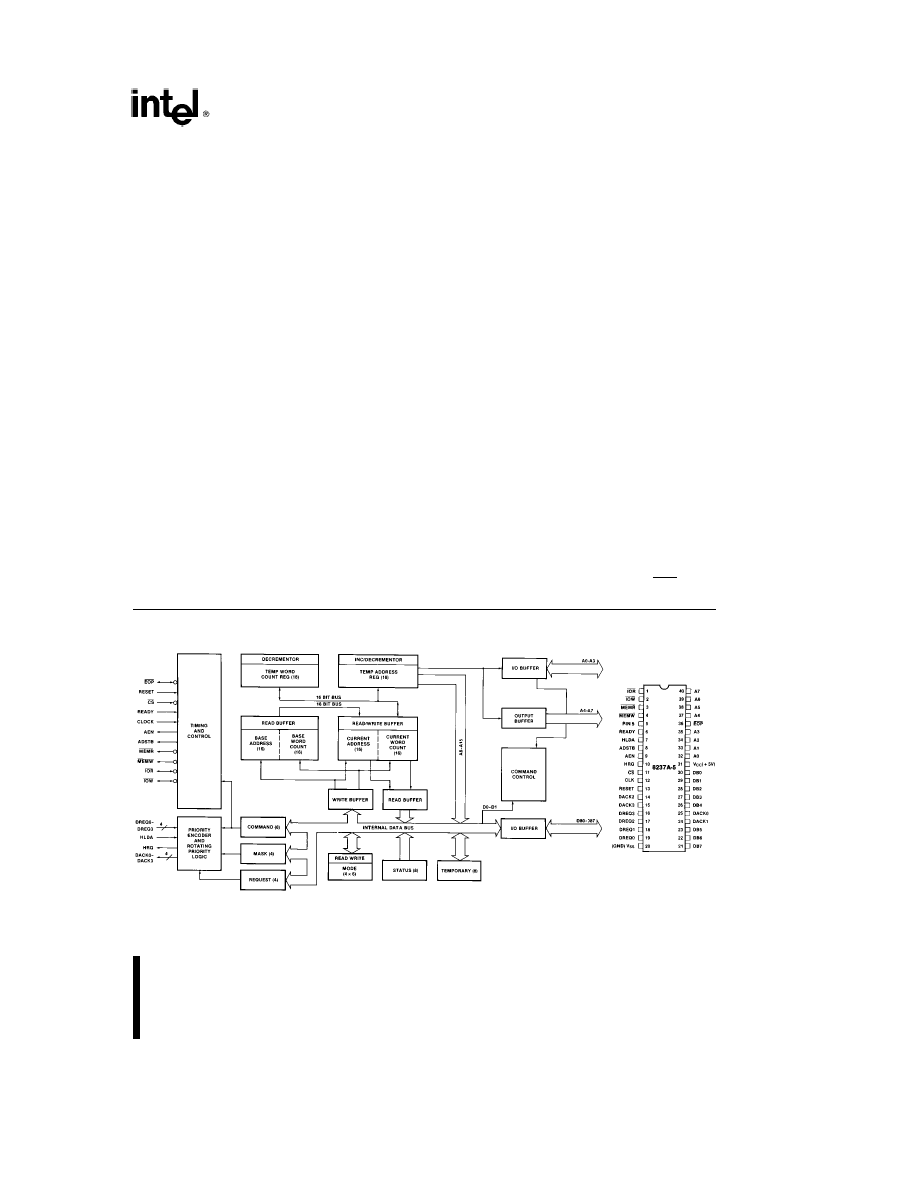
September 1993
Order Number: 231466-005
8237A
HIGH PERFORMANCE
PROGRAMMABLE DMA CONTROLLER
(8237A-5)
Y
Enable/Disable Control of Individual
DMA Requests
Y
Four Independent DMA Channels
Y
Independent Autoinitialization of All
Channels
Y
Memory-to-Memory Transfers
Y
Memory Block Initialization
Y
Address Increment or Decrement
Y
High Performance: Transfers up to
1.6M Bytes/Second with 5 MHz 8237A-5
Y
Directly Expandable to Any Number of
Channels
Y
End of Process Input for Terminating
Transfers
Y
Software DMA Requests
Y
Independent Polarity Control for DREQ
and DACK Signals
Y
Available in EXPRESS
Ð Standard Temperature Range
Y
Available in 40-Lead Cerdip and Plastic
Packages
(See Packaging Spec, Order
Ý
231369)
The 8237A Multimode Direct Memory Access (DMA) Controller is a peripheral interface circuit for microproc-
essor systems. It is designed to improve system performance by allowing external devices to directly transfer
information from the system memory. Memory-to-memory transfer capability is also provided. The 8237A
offers a wide variety of programmable control features to enhance data throughput and system optimization
and to allow dynamic reconfiguration under program control.
The 8237A is designed to be used in conjunction with an external 8-bit address latch. It contains four indepen-
dent channels and may be expanded to any number of channels by cascading additional controller chips. The
three basic transfer modes allow programmability of the types of DMA service by the user. Each channel can
be individually programmed to Autoinitialize to its original condition following an End of Process (EOP). Each
channel has a full 64K address and word count capability.
231466 – 2
Figure 2. Pin
Configuration
231466 – 1
Figure 1. Block Diagram
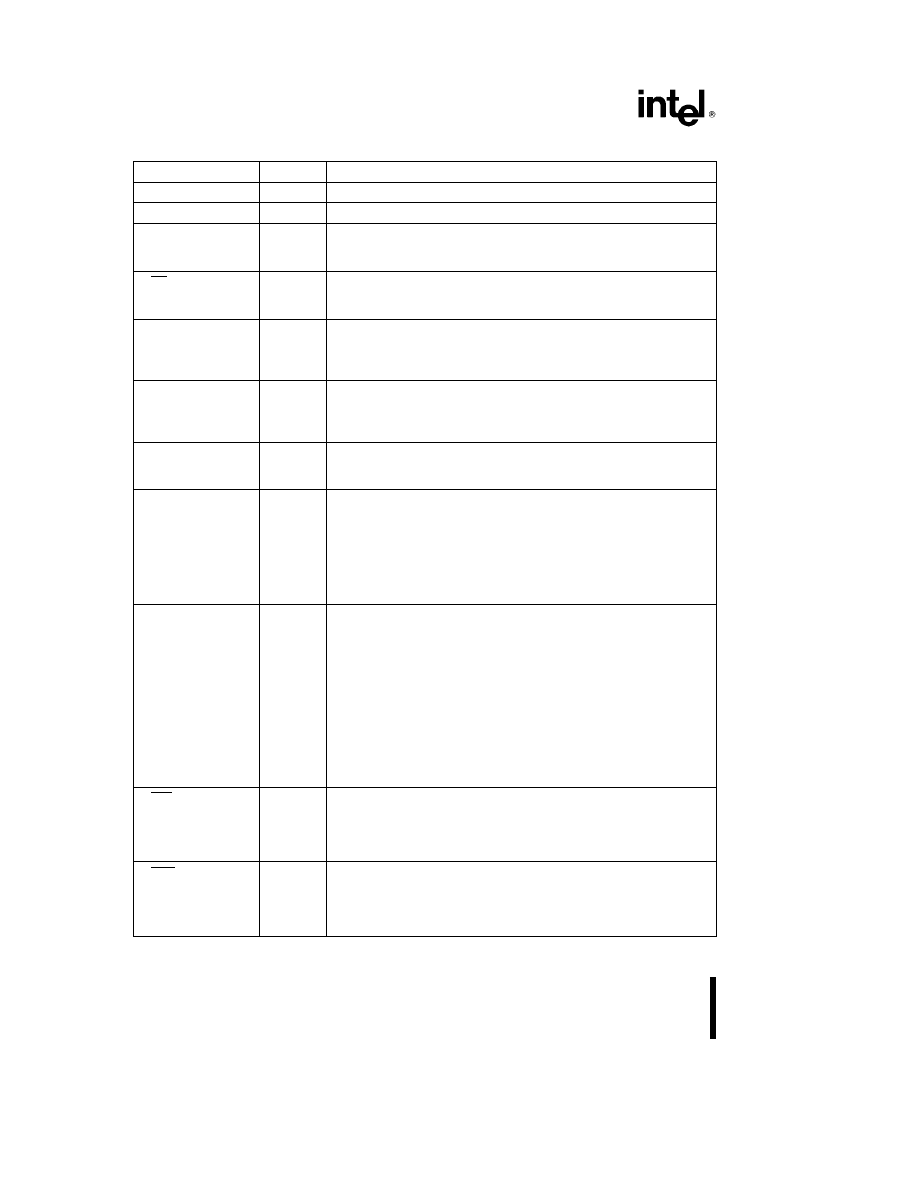
8237A
Table 1. Pin Description
Symbol
Type
Name and Function
V
CC
POWER: a
5V supply.
V
SS
GROUND:
Ground.
CLK
I
CLOCK INPUT:
Clock Input controls the internal operations of the
8237A and its rate of data transfers. The input may be driven at up
to 5 MHz for the 8237A-5.
CS
I
CHIP SELECT:
Chip Select is an active low input used to select
the 8237A as an I/O device during the Idle cycle. This allows CPU
communication on the data bus.
RESET
I
RESET:
Reset is an active high input which clears the Command,
Status, Request and Temporary registers. It also clears the first/
last flip/flop and sets the Mask register. Following a Reset the
device is in the Idle cycle.
READY
I
READY:
Ready is an input used to extend the memory read and
write pulses from the 8237A to accommodate slow memories or
I/O peripheral devices. Ready must not make transitions during its
specified setup/hold time.
HLDA
I
HOLD ACKNOWLEDGE:
The active high Hold Acknowledge from
the CPU indicates that it has relinquished control of the system
busses.
DREQ0 – DREQ3
I
DMA REQUEST:
The DMA Request lines are individual
asynchronous channel request inputs used by peripheral circuits to
obtain DMA service. In fixed Priority, DREQ0 has the highest
priority and DREQ3 has the lowest priority. A request is generated
by activating the DREQ line of a channel. DACK will acknowledge
the recognition of DREQ signal. Polarity of DREQ is
programmable. Reset initializes these lines to active high. DREQ
must be maintained until the corresponding DACK goes active.
DB0 – DB7
I/O
DATA BUS:
The Data Bus lines are bidirectional three-state
signals connected to the system data bus. The outputs are
enabled in the Program condition during the I/O Read to output
the contents of an Address register, a Status register, the
Temporary register or a Word Count register to the CPU. The
outputs are disabled and the inputs are read during an I/O Write
cycle when the CPU is programming the 8237A control registers.
During DMA cycles the most significant 8 bits of the address are
output onto the data bus to be strobed into an external latch by
ADSTB. In memory-to-memory operations, data from the memory
comes into the 8237A on the data bus during the read-from-
memory transfer. In the write-to-memory transfer, the data bus
outputs place the data into the new memory location.
IOR
I/O
I/O READ:
I/O Read is a bidirectional active low three-state line.
In the Idle cycle, it is an input control signal used by the CPU to
read the control registers. In the Active cycle, it is an output control
signal used by the 8237A to access data from a peripheral during a
DMA Write transfer.
IOW
I/O
I/O WRITE:
I/O Write is a bidirectional active low three-state line.
In the Idle cycle, it is an input control signal used by the CPU to
load information into the 8237A. In the Active cycle, it is an output
control signal used by the 8237A to load data to the peripheral
during a DMA Read transfer.
2

8237A
Table 1. Pin Description
(Continued)
Symbol
Type
Name and Function
EOP
I/O
END OF PROCESS:
End of Process is an active low bidirectional
signal. Information concerning the completion of DMA services is
available at the bidirectional EOP pin. The 8237A allows an
external signal to terminate an active DMA service. This is
accomplished by pulling the EOP input low with an external EOP
signal. The 8237A also generates a pulse when the terminal count
(TC) for any channel is reached. This generates an EOP signal
which is output through the EOP line. The reception of EOP, either
internal or external, will cause the 8237A to terminate the service,
reset the request, and, if Autoinitialize is enabled, to write the base
registers to the current registers of that channel. The mask bit and
TC bit in the status word will be set for the currently active channel
by EOP unless the channel is programmed for Autoinitialize. In that
case, the mask bit remains unchanged. During memory-to-memory
transfers, EOP will be output when the TC for channel 1 occurs.
EOP should be tied high with a pull-up resistor if it is not used to
prevent erroneous end of process inputs.
A0 – A3
I/O
ADDRESS:
The four least significant address lines are
bidirectional three-state signals. In the Idle cycle they are inputs
and are used by the CPU to address the register to be loaded or
read. In the Active cycle they are outputs and provide the lower 4
bits of the output address.
A4 – A7
O
ADDRESS:
The four most significant address lines are three-state
outputs and provide 4 bits of address. These lines are enabled
only during the DMA service.
HRQ
O
HOLD REQUEST:
This is the Hold Request to the CPU and is
used to request control of the system bus. If the corresponding
mask bit is clear, the presence of any valid DREQ causes 8237A to
issue the HRQ.
DACK0 – DACK3
O
DMA ACKNOWLEDGE:
DMA Acknowledge is used to notify the
individual peripherals when one has been granted a DMA cycle.
The sense of these lines is programmable. Reset initializes them
to active low.
AEN
O
ADDRESS ENABLE:
Address Enable enables the 8-bit latch
containing the upper 8 address bits onto the system address bus.
AEN can also be used to disable other system bus drivers during
DMA transfers. AEN is active HIGH.
ADSTB
O
ADDRESS STROBE:
The active high, Address Strobe is used to
strobe the upper address byte into an external latch.
MEMR
O
MEMORY READ:
The Memory Read signal is an active low three-
state output used to access data from the selected memory
location during a DMA Read or a memory-to-memory transfer.
MEMW
O
MEMORY WRITE:
The Memory Write is an active low three-state
output used to write data to the selected memory location during a
DMA Write or a memory-to-memory transfer.
PIN5
I
PIN5:
This pin should always be at a logic HIGH level. An internal
pull-up resistor will establish a logic high when the pin is left
floating. It is recommended however, that PIN5 be connected to
V
CC
.
3
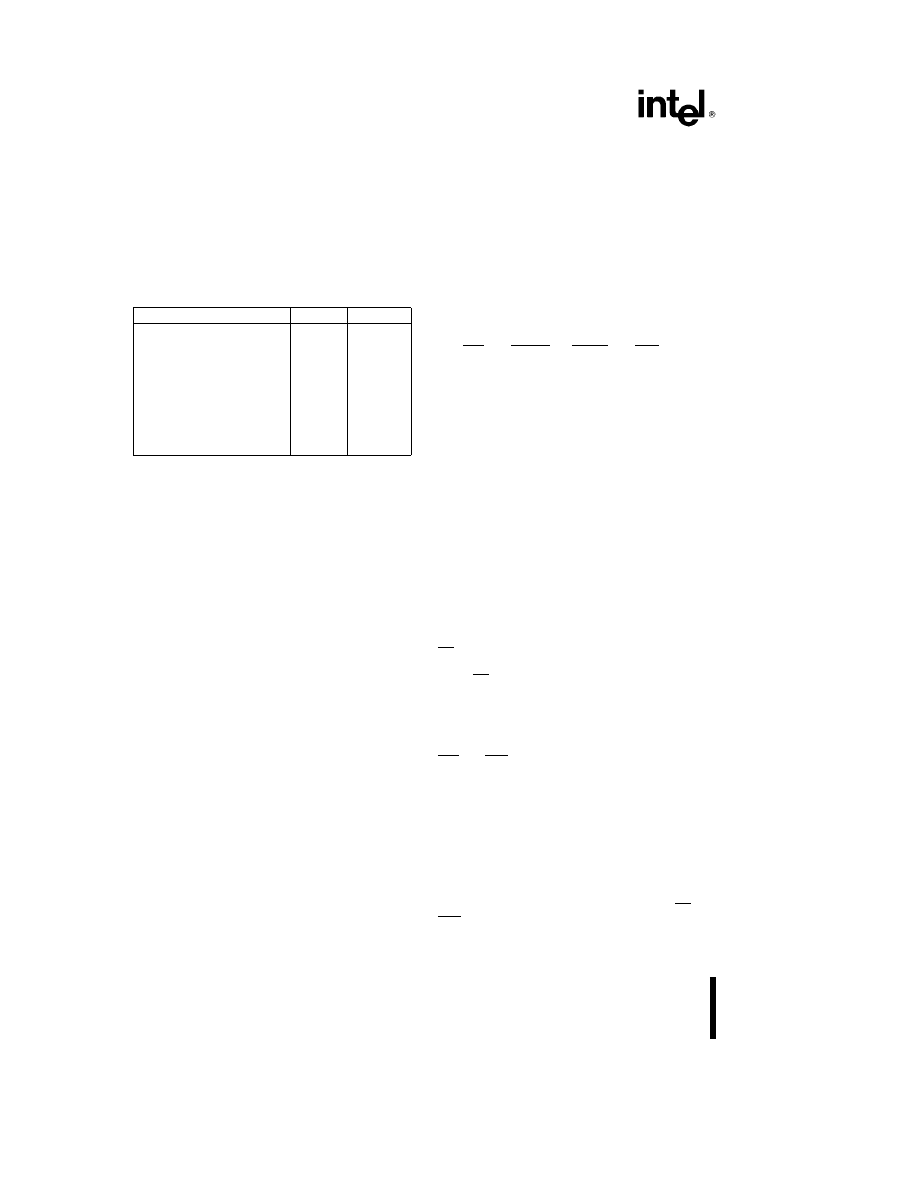
8237A
FUNCTIONAL DESCRIPTION
The 8237A block diagram includes the major logic
blocks and all of the internal registers. The data in-
terconnection paths are also shown. Not shown are
the various control signals between the blocks. The
8237A contains 344 bits of internal memory in the
form of registers. Figure 3 lists these registers by
name and shows the size of each. A detailed de-
scription of the registers and their functions can be
found under Register Description.
Name
Size
Number
Base Address Registers
16 bits
4
Base Word Count Registers
16 bits
4
Current Address Registers
16 bits
4
Current Word Count Registers
16 bits
4
Temporary Address Register
16 bits
1
Temporary Word Count Register
16 bits
1
Status Register
8 bits
1
Command Register
8 bits
1
Temporary Register
8 bits
1
Mode Registers
6 bits
4
Mask Register
4 bits
1
Request Register
4 bits
1
Figure 3. 8237A Internal Registers
The 8237A contains three basic blocks of control
logic. The Timing Control block generates internal
timing and external control signals for the 8237A.
The Program Command Control block decodes the
various commands given to the 8237A by the micro-
processor prior to servicing a DMA Request. It also
decodes the Mode Control word used to select the
type of DMA during the servicing. The Priority En-
coder block resolves priority contention between
DMA channels requesting service simultaneously.
The Timing Control block derives internal timing
from the clock input. In 8237A systems, this input
will usually be the w2 TTL clock from an 8224 or
CLK from an 8085AH or 8284A. 33% duty cycle
clock generators, however, may not meet the clock
high time requirement of the 8237A of the same fre-
quency. For example, 82C84A-5 CLK output violates
the clock high time requirement of 8237A-5. In this
case 82C84A CLK can simply be inverted to meet
8237A-5 clock high and low time requirements. For
8085AH-2 systems above 3.9 MHz, the 8085
CLK(OUT) does not satisfy 8237A-5 clock LOW and
HIGH time requirements. In this case, an external
clock should be used to drive the 8237A-5.
DMA OPERATION
The 8237A is designed to operate in two major cy-
cles. These are called Idle and Active cycles. Each
device cycle is made up of a number of states. The
8237A can assume seven separate states, each
composed of one full clock period. State I (SI) is the
inactive state. It is entered when the 8237A has no
valid DMA requests pending. While in SI, the DMA
controller is inactive but may be in the Program Con-
dition, being programmed by the processor. State
S0 (S0) is the first state of a DMA service. The
8237A has requested a hold but the processor has
not yet returned an acknowledge. The 8237A may
still be programmed until it receives HLDA from the
CPU. An acknowledge from the CPU will signal that
DMA transfers may begin. S1, S2, S3 and S4 are the
working states of the DMA service. If more time is
needed to complete a transfer than is available with
normal timing, wait states (SW) can be inserted be-
tween S2 or S3 and S4 by the use of the Ready line
on the 8237A. Note that the data is transferred di-
rectly from the I/O device to memory (or vice versa)
with IOR and MEMW (or MEMR and IOW) being ac-
tive at the same time. The data is not read into or
driven out of the 8237A in I/O-to-memory or memo-
ry-to-I/O DMA transfers.
Memory-to-memory transfers require a read-from
and a write-to-memory to complete each transfer.
The states, which resemble the normal working
states, use two digit numbers for identification. Eight
states are required for a single transfer. The first four
states (S11, S12, S13, S14) are used for the read-
from-memory half and the last four states (S21, S22,
S23, S24) for the write-to-memory half of the trans-
fer.
IDLE CYCLE
When no channel is requesting service, the 8237A
will enter the Idle cycle and perform ‘‘SI’’ states. In
this cycle the 8237A will sample the DREQ lines ev-
ery clock cycle to determine if any channel is re-
questing a DMA service. The device will also sample
CS, looking for an attempt by the microprocessor to
write or read the internal registers of the 8237A.
When CS is low and HLDA is low, the 8237A enters
the Program Condition. The CPU can now establish,
change or inspect the internal definition of the part
by reading from or writing to the internal registers.
Address lines A0 – A3 are inputs to the device and
select which registers will be read or written. The
IOR and IOW lines are used to select and time reads
or writes. Due to the number and size of the internal
registers, an internal flip-flop is used to generate an
additional bit of address. This bit is used to deter-
mine the upper or lower byte of the 16-bit Address
and Word Count registers. The flip-flop is reset by
Master Clear or Reset. A separate software com-
mand can also reset this flip-flop.
Special software commands can be executed by the
8237A in the Program Condition. These commands
are decoded as sets of addresses with the CS and
IOW. The commands do not make use of the data
bus. Instructions include Clear First/Last Flip-Flop
and Master Clear.
4
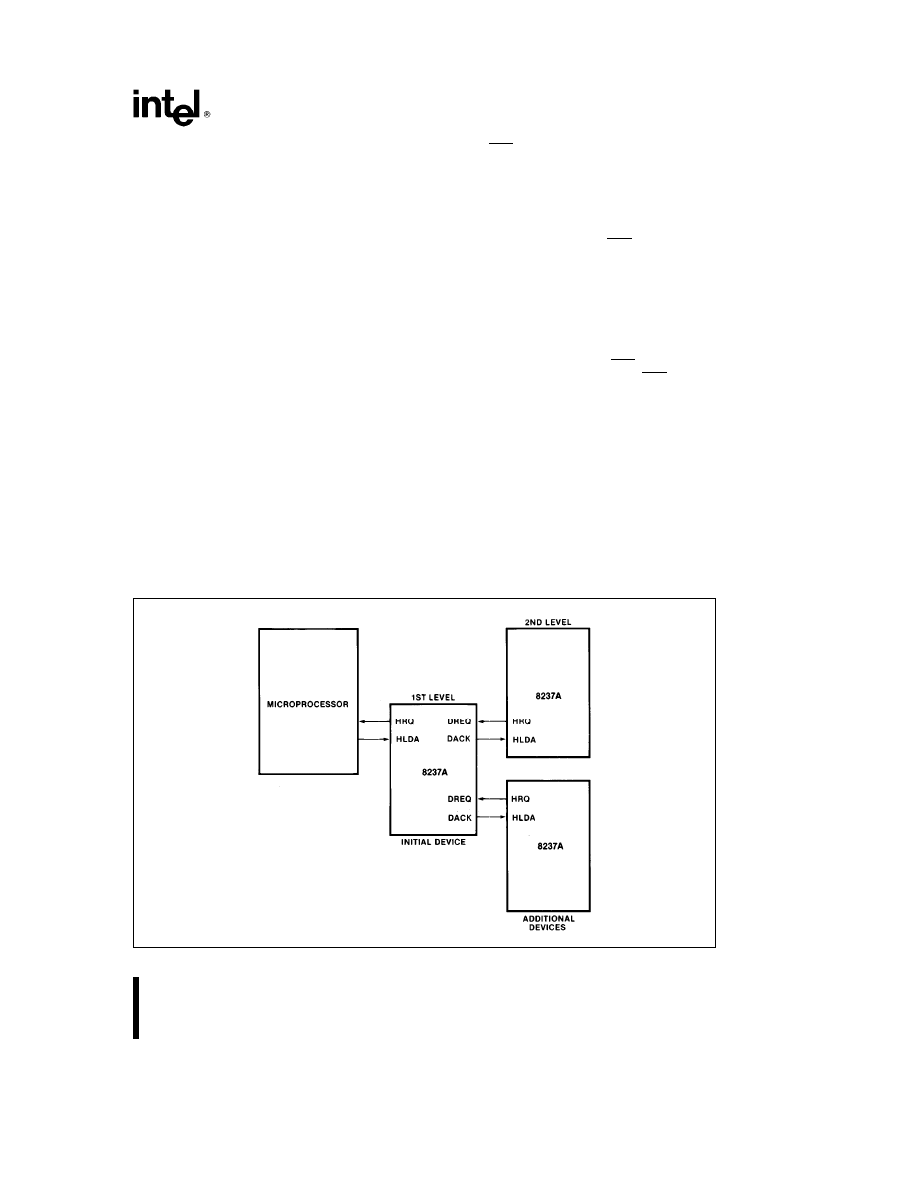
8237A
ACTIVE CYCLE
When the 8237A is in the Idle cycle and a non-
masked channel requests a DMA service, the device
will output an HRQ to the microprocessor and enter
the Active cycle. It is in this cycle that the DMA serv-
ice will take place, in one of four modes:
Single Transfer Mode
ÐIn Single Transfer mode
the device is programmed to make one transfer only.
The word count will be decremented and the ad-
dress decremented or incremented following each
transfer. When the word count ‘‘rolls over’’ from zero
to FFFFH, a Terminal Count (TC) will cause an Auto-
initialize if the channel has been programmed to do
so.
DREQ must be held active until DACK becomes ac-
tive in order to be recognized. If DREQ is held active
throughout the single transfer, HRQ will go inactive
and release the bus to the system. It will again go
active and, upon receipt of a new HLDA, another
single transfer will be performed. In 8080A, 8085AH,
8088, or 8086 system, this will ensure one full ma-
chine cycle execution between DMA transfers. De-
tails of timing between the 8237A and other bus
control protocols will depend upon the characteris-
tics of the microprocessor involved.
Block Transfer Mode
ÐIn Block Transfer mode the
device is activated by DREQ to continue making
transfers during the service until a TC, caused by
word count going to FFFFH, or an external End of
Process (EOP) is encountered. DREQ need only be
held active until DACK becomes active. Again, an
Autoinitialization will occur at the end of the service
if the channel has been programmed for it.
Demand Transfer Mode
ÐIn Demand Transfer
mode the device is programmed to continue making
transfers until a TC or external EOP is encountered
or until DREQ goes inactive. Thus transfers may
continue until the I/O device has exhausted its data
capacity. After the I/O device has had a chance to
catch up, the DMA service is re-established by
means of a DREQ. During the time between services
when the microprocessor is allowed to operate, the
intermediate values of address and word count are
stored in the 8237A Current Address and Current
Word Count registers. Only an EOP can cause an
Autoinitialize at the end of the service. EOP is gener-
ated either by TC or by an external signal. DREQ
has to be low before S4 to prevent another Transfer.
Cascade Mode
ÐThis mode is used to cascade
more than one 8237A together for simple system
expansion. The HRQ and HLDA signals from the ad-
ditional 8237A are connected to the DREQ and
DACK signals of a channel of the initial 8237A. This
allows the DMA requests of the additional device to
propagate through the priority network circuitry of
the preceding device. The priority chain is preserved
and the new device must wait for its turn to acknowl-
edge requests. Since the cascade channel of the
initial 8237A is used only for prioritizing the addition-
al device, it does not output any address or control
231466 – 3
Figure 4. Cascaded 8237As
5
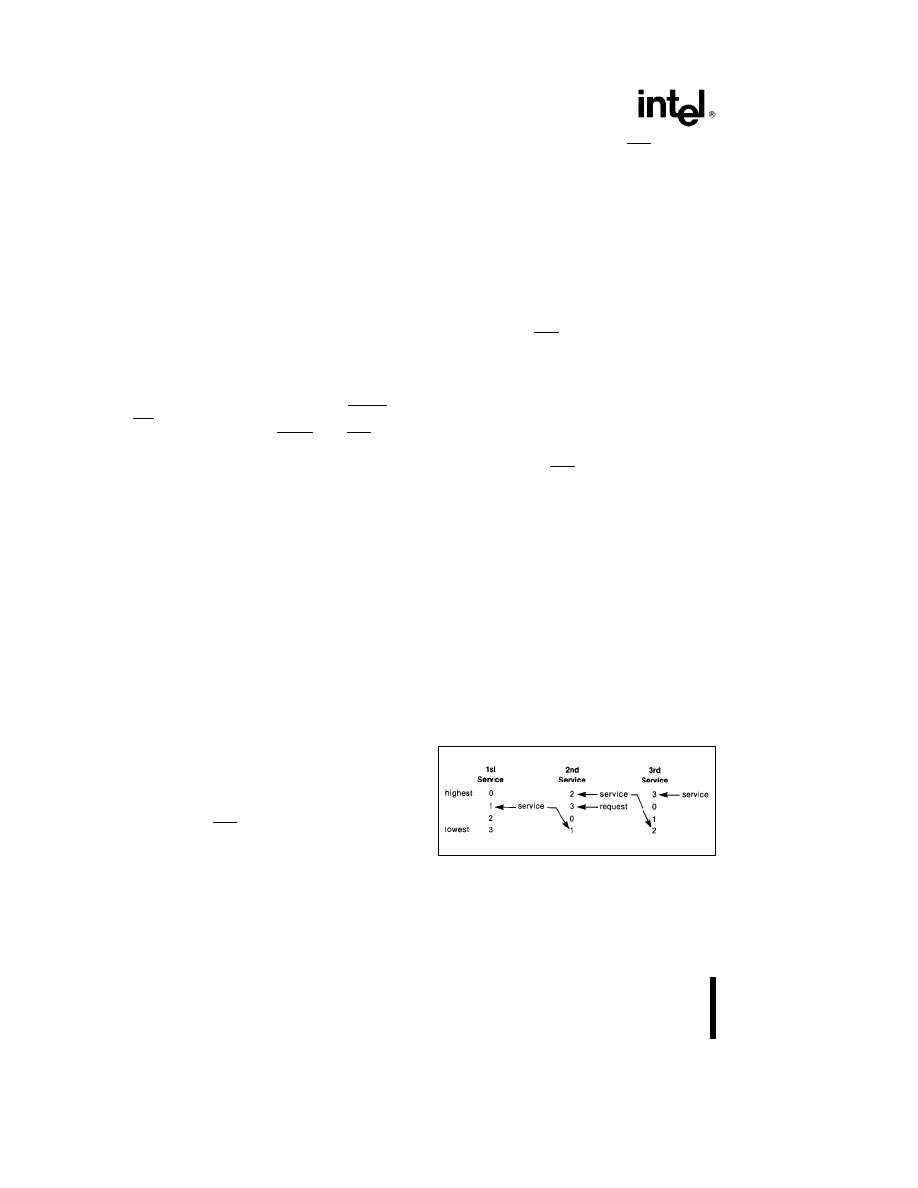
8237A
signals of its own. These could conflict with the out-
puts of the active channel in the added device. The
8237A will respond to DREQ and DACK but all other
outputs except HRQ will be disabled. The ready in-
put is ignored.
Figure 4 shows two additional devices cascaded into
an initial device using two of the previous channels.
This forms a two level DMA system. More 8237As
could be added at the second level by using the
remaining channels of the first level. Additional de-
vices can also be added by cascading into the chan-
nels of the second level device, forming a third level.
TRANSFER TYPES
Each of the three active transfer modes can perform
three different types of transfers. These are Read,
Write and Verify. Write transfers move data from an
I/O device to the memory by activating MEMW and
IOR. Read transfers move data from memory to an
I/O device by activating MEMR and IOW. Verify
transfers are pseudo transfers. The 8237A operates
as in Read or Write transfers generating addresses,
and responding to EOP, etc. However, the memory
and I/O control lines all remain inactive. The ready
input is ignored in verify mode.
Memory-to-Memory
ÐTo perform block moves of
data from one memory address space to another
with a minimum of program effort and time, the
8237A includes a memory-to-memory transfer fea-
ture. Programming a bit in the Command register
selects channels 0 and 1 to operate as memory-to-
memory transfer channels. The transfer is initiated
by setting the software DREQ for channel 0. The
8237A requests a DMA service in the normal man-
ner. After HLDA is true, the device, using four state
transfers in Block Transfer mode, reads data from
the memory. The channel 0 Current Address register
is the source for the address used and is decrement-
ed or incremented in the normal manner. The data
byte read from the memory is stored in the 8237A
internal Temporary register. Channel 1 then per-
forms a four-state transfer of the data from the Tem-
porary register to memory using the address in its
Current Address register and incrementing or decre-
menting it in the normal manner. The channel 1 cur-
rent Word Count is decremented. When the word
count of channel 1 goes to FFFFH, a TC is generat-
ed causing an EOP output terminating the service.
Channel 0 may be programmed to retain the same
address for all transfers. This allows a single word to
be written to a block of memory.
The 8237A will respond to external EOP signals dur-
ing memory-to-memory transfers. Data comparators
in block search schemes may use this input to termi-
nate the service when a match is found. The timing
of memory-to-memory transfers is found in Figure
12. Memory-to-memory operations can be detected
as an active AEN with no DACK outputs.
Autoinitialize
ÐBy programming a bit in the Mode
register, a channel may be set up as an Autoinitialize
channel. During Autoinitialize initialization, the origi-
nal values of the Current Address and Current Word
Count registers are automatically restored from the
Base Address and Base Word count registers of that
channel following EOP. The base registers are load-
ed simultaneously with the current registers by the
microprocessor and remain unchanged throughout
the DMA service. The mask bit is not altered when
the channel is in Autoinitialize. Following Autoinitial-
ize the channel is ready to perform another DMA
service, without CPU intervention, as soon as a valid
DREQ is detected. In order to Autoinitialize both
channels in a memory-to-memory transfer, both
word counts should be programmed identically. If in-
terrupted externally, EOP pulses should be applied
in both bus cycles.
Priority
ÐThe 8237A has two types of priority en-
coding available as software selectable options. The
first is Fixed Priority which fixes the channels in pri-
ority order based upon the descending value of their
number. The channel with the lowest priority is 3
followed by 2, 1 and the highest priority channel, 0.
After the recognition of any one channel for service,
the other channels are prevented from interfering
with that service until it is completed.
After completion of a service, HRQ will go inactive
and the 8237A will wait for HLDA to go low before
activating HRQ to service another channel.
The second scheme is Rotating Priority. The last
channel to get service becomes the lowest priority
channel with the others rotating accordingly.
231466 – 4
6

8237A
With Rotating Priority in a single chip DMA system,
any device requesting service is guaranteed to be
recognized after no more than three higher priority
services have occurred. This prevents any one
channel from monopolizing the system.
Compressed Timing
ÐIn order to achieve even
greater throughput where system characteristics
permit, the 8237A can compress the transfer time to
two clock cycles. From Figure 11 it can be seen that
state S3 is used to extend the access time of the
read pulse. By removing state S3, the read pulse
width is made equal to the write pulse width and a
transfer consists only of state S2 to change the ad-
dress and state S4 to perform the read/write. S1
states will still occur when A8 – A15 need updating
(see Address Generation). Timing for compressed
transfers is found in Figure 14.
Address Generation
ÐIn order to reduce pin count,
the 8237A multiplexes the eight higher order ad-
dress bits on the data lines. State S1 is used to out-
put the higher order address bits to an external latch
from which they may be placed on the address bus.
The falling edge of Address Strobe (ADSTB) is used
to load these bits from the data lines to the latch.
Address Enable (AEN) is used to enable the bits
onto the address bus through a three-state enable.
The lower order address bits are output by the
8237A directly. Lines A0 – A7 should be connected
to the address bus. Figure 11 shows the time rela-
tionships between CLK, AEN, ADSTB, DB0 – DB7
and A0 – A7.
During Block and Demand Transfer mode services,
which include multiple transfers, the addresses gen-
erated will be sequential. For many transfers the
data held in the external address latch will remain
the same. This data need only change when a carry
or borrow from A7 to A8 takes place in the normal
sequence of addresses. To save time and speed
transfers, the 8237A executes S1 states only when
updating of A8 – A15 in the latch is necessary. This
means for long services, S1 states and Address
Strobes may occur only once every 256 transfers, a
savings of 255 clock cycles for each 256 transfers.
REGISTER DESCRIPTION
Current Address Register
ÐEach channel has a
16-bit Current Address register. This register holds
the value of the address used during DMA transfers.
The address is automatically incremented or decre-
mented after each transfer and the intermediate val-
ues of the address are stored in the Current Address
register during the transfer. This register is written or
read by the microprocessor in successive 8-bit
bytes. It may also be reinitialized by an Autoinitialize
back to its original value. Autoinitialize takes place
only after an EOP.
Current Word Register
ÐEach channel has a 16-
bit Current Word Count register. This register deter-
mines the number of transfers to be performed. The
actual number of transfers will be one more than the
number programmed in the Current Word Count reg-
ister (i.e., programming a count of 100 will result in
101 transfers). The word count is decremented after
each transfer. The intermediate value of the word
count is stored in the register during the transfer.
When the value in the register goes from zero to
FFFFH, a TC will be generated. This register is load-
ed or read in successive 8-bit bytes by the micro-
processor in the Program Condition. Following the
end of a DMA service it may also be reinitialized by
an Autoinitialization back to its original value. Auto-
initialize can occur only when an EOP occurs. If it is
not Autoinitialized, this register will have a count of
FFFFH after TC.
Base Address and Base Word Count Registers
Ð
Each channel has a pair of Base Address and Base
Word Count registers. These 16-bit registers store
the original value of their associated current regis-
ters. During Autoinitialize these values are used to
restore the current registers to their original values.
The base registers are written simultaneously with
their corresponding current register in 8-bit bytes in
the Program Condition by the microprocessor.
These registers cannot be read by the microproces-
sor.
Command Register
ÐThis 8-bit register controls
the operation of the 8237A. It is programmed by the
microprocessor in the Program Condition and is
cleared by Reset or a Master Clear instruction. The
following table lists the function of the command
bits. See Figure 6 for address coding.
Mode Register
ÐEach channel has a 6-bit Mode
register associated with it. When the register is being
written to by the microprocessor in the Program
Condition, bits 0 and 1 determine which channel
Mode register is to be written.
Request Register
ÐThe 8237A can respond to re-
quests for DMA service which are initiated by soft-
ware as well as by a DREQ. Each channel has a
request bit associated with it in the 4-bit Request
register. These are non-maskable and subject to pri-
oritization by the Priority Encoder network. Each reg-
ister bit is set or reset separately under software
control or is cleared upon generation of a TC or ex-
ternal EOP. The entire register is cleared by a Reset.
To set or reset a bit, the software loads the proper
form of the data word. See Figure 5 for register ad-
dress coding. In order to make a software request,
the channel must be in Block Mode.
7
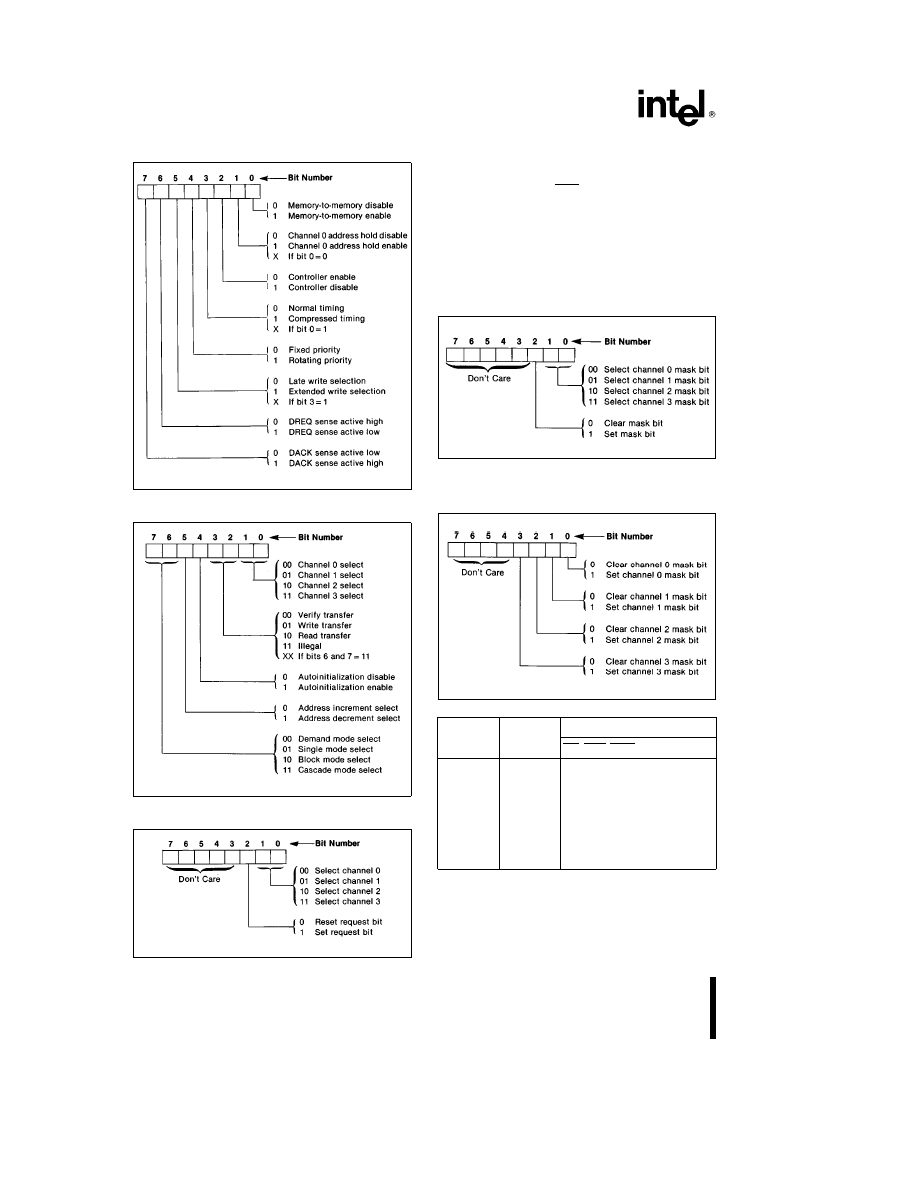
8237A
Command Register
231466 – 5
Mode Register
231466 – 6
Request Register
231466 – 7
Mask Register
ÐEach channel has associated with
it a mask bit which can be set to disable the incom-
ing DREQ. Each mask bit is set when its associated
channel produces an EOP if the channel is not pro-
grammed for Autoinitialize. Each bit of the 4-bit
Mask register may also be set or cleared separately
under software control. The entire register is also set
by a Reset. This disables all DMA requests until a
clear Mask register instruction allows them to occur.
The instruction to separately set or clear the mask
bits is similar in form to that used with the Request
register. See Figure 5 for instruction addressing.
231466 – 8
All four bits of the Mask register may also be written
with a single command.
231466 – 9
Register Operation
Signals
CS IOR IOW A3 A2 A1 A0
Command Write
0
1
0
1
0
0
0
Mode
Write
0
1
0
1
0
1
1
Request
Write
0
1
0
1
0
0
1
Mask
Set/Reset 0
1
0
1
0
1
0
Mask
Write
0
1
0
1
1
1
1
Temporary Read
0
0
1
1
1
0
1
Status
Read
0
0
1
1
0
0
0
Figure 5. Definition of Register Codes
Status Register
ÐThe Status register is available to
be read out of the 8237A by the microprocessor. It
contains information about the status of the devices
at this point. This information includes which chan-
nels have reached a terminal count and which chan-
8
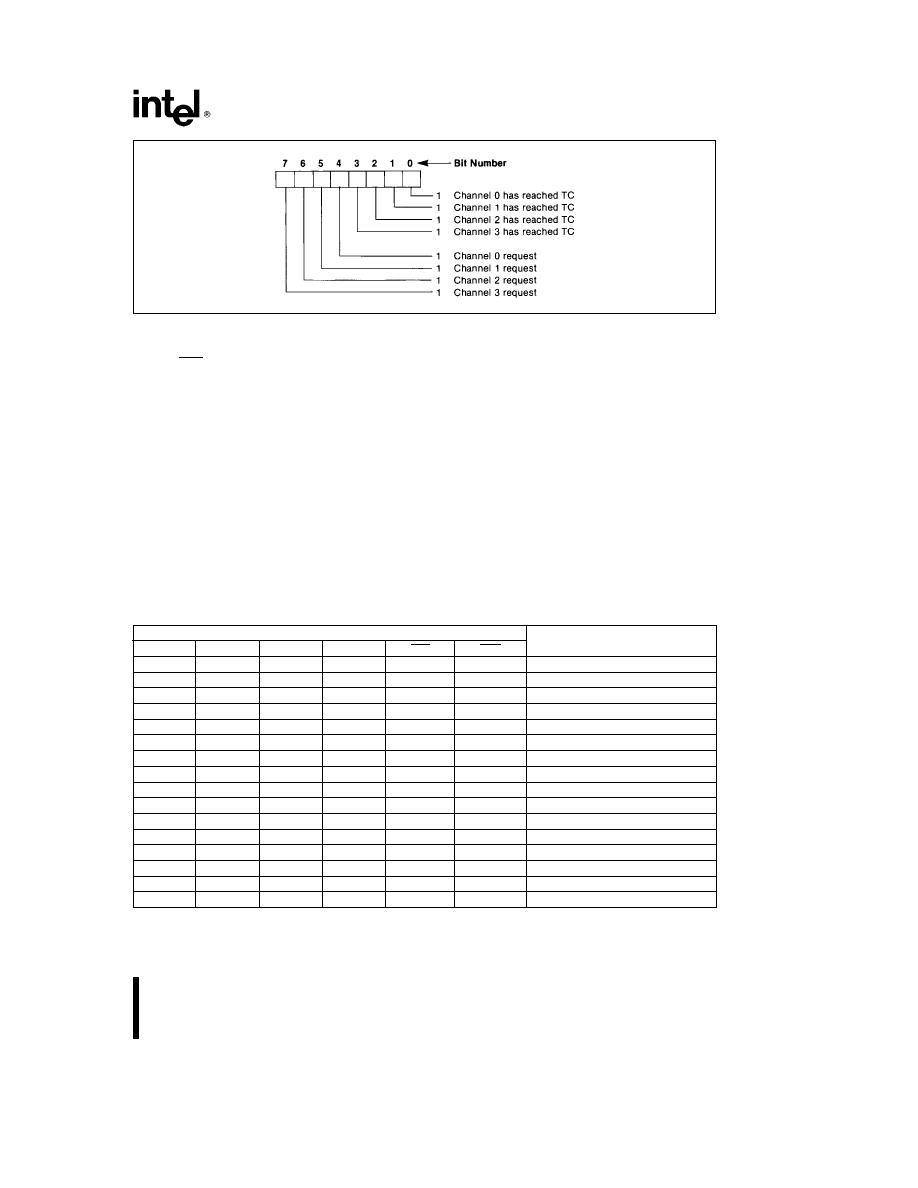
8237A
231466 – 10
nels have pending DMA requests. Bits 0 – 3 are set
every time a TC is reached by that channel or an
external EOP is applied. These bits are cleared upon
Reset and on each Status Read. Bits 4 – 7 are set
whenever their corresponding channel is requesting
service.
Temporary Register
ÐThe Temporary register is
used to hold data during memory-to-memory trans-
fers. Following the completion of the transfers, the
last word moved can be read by the microprocessor
in the Program Condition. The Temporary register
always contains the last byte transferred in the previ-
ous memory-to-memory operation, unless cleared
by a Reset.
Software Commands
ÐThese are additional spe-
cial software commands which can be executed in
the Program Condition. They do not depend on any
specific bit pattern on the data bus. The three soft-
ware commands are:
Clear First/Last Flip-Flop:
This command must be
executed prior to writing or reading new address
or word count information to the 8237A. This ini-
tializes the flip-flop to a known state so that sub-
sequent accesses to register contents by the mi-
croprocessor will address upper and lower bytes
in the correct sequence.
Master Clear:
This software instruction has the
same effect as the hardware Reset. The Com-
mand, Status, Request, Temporary, and Internal
First/Last Flip-Flop registers are cleared and the
Mask register is set. The 8237A will enter the Idle
cycle.
Clear Mask Register:
This command clears the
mask bits of all four channels, enabling them to
accept DMA requests.
Figure 6 lists the address codes for the software
commands.
Signals
Operation
A3
A2
A1
A0
IOR
IOW
1
0
0
0
0
1
Read Status Register
1
0
0
0
1
0
Write Command Register
1
0
0
1
0
1
Illegal
1
0
0
1
1
0
Write Request Register
1
0
1
0
0
1
Illegal
1
0
1
0
1
0
Write Single Mask Register Bit
1
0
1
1
0
1
Illegal
1
0
1
1
1
0
Write Mode Register
1
1
0
0
0
1
Illegal
1
1
0
0
1
0
Clear Byte Pointer Flip/Flop
1
1
0
1
0
1
Read Temporary Register
1
1
0
1
1
0
Master Clear
1
1
1
0
0
1
Illegal
1
1
1
0
1
0
Clear Mask Register
1
1
1
1
0
1
Illegal
1
1
1
1
1
0
Write All Mask Register Bits
Figure 6. Software Command Codes
9

8237A
Channel
Register
Operation
Signals
Internal
Data Bus
CS IOR IOW A3 A2 A1 A0 Flip-Flop DB0 – DB7
0
Base and Current Address
Write
0
1
0
0
0
0
0
0
A0 – A7
0
1
0
0
0
0
0
1
A8 – A15
Current Address
Read
0
0
1
0
0
0
0
0
A0 – A7
0
0
1
0
0
0
0
1
A8 – A15
Base and Current Word Count
Write
0
1
0
0
0
0
1
0
W0 – W7
0
1
0
0
0
0
1
1
W8 – W15
Current Word Count
Read
0
0
1
0
0
0
1
0
W0 – W7
0
0
1
0
0
0
1
1
W8 – W15
1
Base and Current Address
Write
0
1
0
0
0
1
0
0
A0 – A7
0
1
0
0
0
1
0
1
A8 – A15
Current Address
Read
0
0
1
0
0
1
0
0
A0 – A7
0
0
1
0
0
1
0
1
A8 – A15
Base and Current Word Count
Write
0
1
0
0
0
1
1
0
W0 – W7
0
1
0
0
0
1
1
1
W8 – W15
Current Word Count
Read
0
0
1
0
0
1
1
0
W0 – W7
0
0
1
0
0
1
1
1
W8 – W15
2
Base and Current Address
Write
0
1
0
0
1
0
0
0
A0 – A7
0
1
0
0
1
0
0
1
A8 – A15
Current Address
Read
0
0
1
0
1
0
0
0
A0 – A7
0
0
1
0
1
0
0
1
A8 – A15
Base and Current Word Count
Write
0
1
0
0
1
0
1
0
W0 – W7
0
1
0
0
1
0
1
1
W8 – W15
Current Word Count
Read
0
0
1
0
1
0
1
0
W0 – W7
0
0
1
0
1
0
1
1
W8 – W15
3
Base and Current Address
Write
0
1
0
0
1
1
0
0
A0 – A7
0
1
0
0
1
1
0
1
A8 – A15
Current Address
Read
0
0
1
0
1
1
0
0
A0 – A7
0
0
1
0
1
1
0
1
A8 – A15
Base and Current Word Count
Write
0
1
0
0
1
1
1
0
W0 – W7
0
1
0
0
1
1
1
1
W8 – W15
Current Word Count
Read
0
0
1
0
1
1
1
0
W0 – W7
0
0
1
0
1
1
1
1
W8 – W15
Figure 7. Word Count and Address Register Command Codes
10
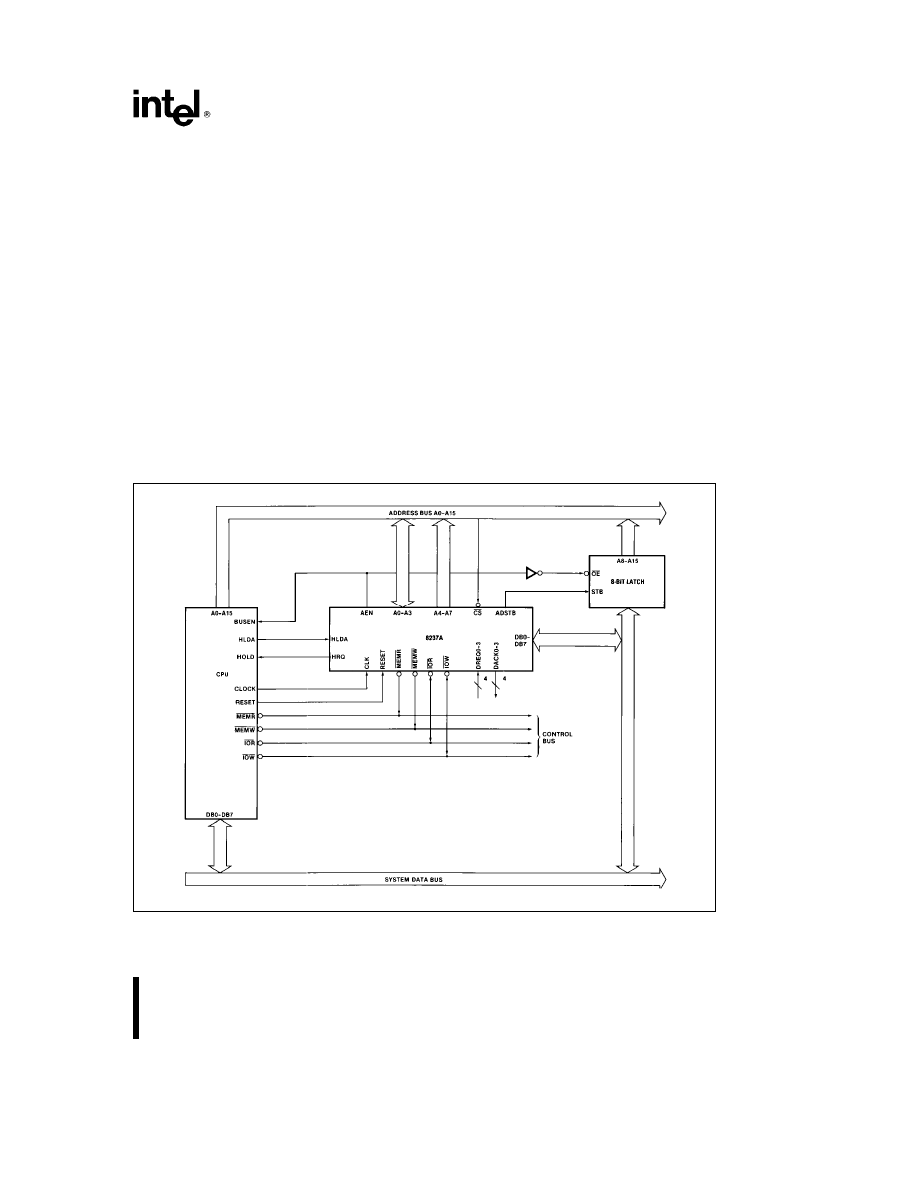
8237A
PROGRAMMING
The 8237A will accept programming from the host
processor any time that HLDA is inactive; this is true
even if HRQ is active. The responsibility of the host
is to assure that programming and HLDA are mutual-
ly exclusive. Note that a problem can occur if a DMA
request occurs, on an unmasked channel while the
8237A is being programmed. For instance, the CPU
may be starting to reprogram the two byte Address
register of channel 1 when channel 1 receives a
DMA request. If the 8237A is enabled (bit 2 in the
command register is 0) and channel 1 is unmasked,
a DMA service will occur after only one byte of the
Address register has been reprogrammed. This can
be avoided by disabling the controller (setting bit 2 in
the command register) or masking the channel be-
fore programming any other registers. Once the pro-
gramming is complete, the controller can be en-
abled/unmasked.
After power-up it is suggested that all internal loca-
tions, especially the Mode registers, be loaded with
some valid value. This should be done even if some
channels are unused. An invalid mode may force all
control signals to go active at the same time.
APPLICATION INFORMATION
(Note 1)
Figure 8 shows a convenient method for configuring
a DMA system with the 8237A controller and an
8080A/8085AH microprocessor system. The multi-
mode DMA controller issues a HRQ to the processor
whenever there is at least one valid DMA request
from a peripheral device. When the processor re-
plies with a HLDA signal, the 8237A takes control of
the address bus, the data bus and the control bus.
The address for the first transfer operation comes
out in two bytesÐthe least significant 8 bits on the
eight address outputs and the most significant 8 bits
on the data bus. The contents of the data bus are
then latched into an 8-bit latch to complete the full
16 bits of the address bus. The 8282 is a high
speed, 8-bit, three-state latch in a 20-pin package.
After the initial transfer takes place, the latch is up-
dated only after a carry or borrow is generated in the
least significant address byte. Four DMA channels
are provided when one 8237A is used.
231466 – 11
Figure 8. 8237A System Interface
NOTE:
1. See Application Note AP-67 for 8086 design information.
11
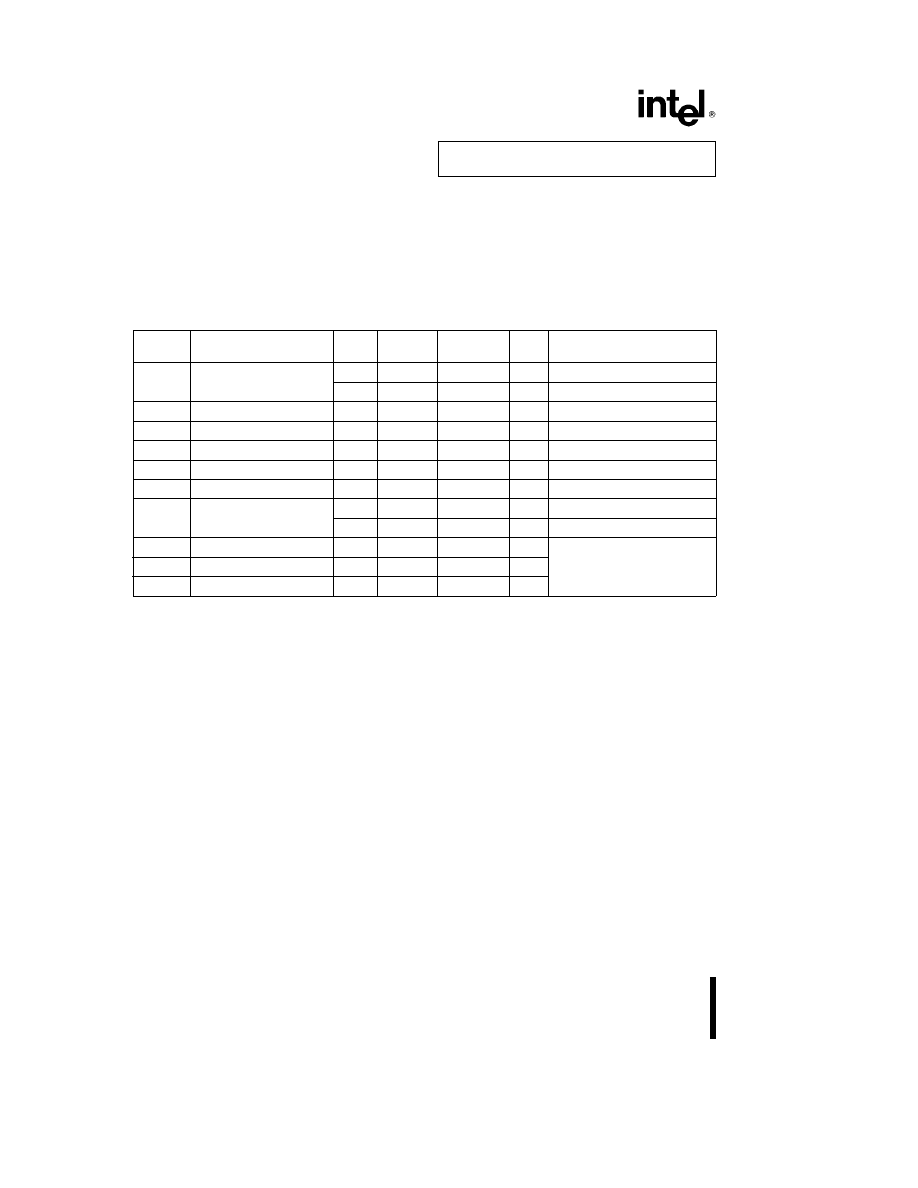
8237A
ABSOLUTE MAXIMUM RATINGS
*
Ambient Temperature under Bias ÀÀÀÀÀÀ0
§
C to 70
§
C
Case Temperature ÀÀÀÀÀÀÀÀÀÀÀÀÀÀÀÀÀ0
§
C to a75
§
C
Storage Temperature ÀÀÀÀÀÀÀÀÀÀb65
§
C to a150
§
C
Voltage on Any Pin with
Respect to GroundÀÀÀÀÀÀÀÀÀÀÀÀÀÀb0.5V to a7V
Power Dissipation ÀÀÀÀÀÀÀÀÀÀÀÀÀÀÀÀÀÀÀÀÀÀÀ1.5 Watt
NOTICE: This is a production data sheet. The specifi-
cations are subject to change without notice.
*
WARNING: Stressing the device beyond the ‘‘Absolute
Maximum Ratings’’ may cause permanent damage.
These are stress ratings only. Operation beyond the
‘‘Operating Conditions’’ is not recommended and ex-
tended exposure beyond the ‘‘Operating Conditions’’
may affect device reliability.
D.C. CHARACTERISTICS
T
A
e
0
§
C to 70
§
C, T
CASE
e
0
§
C to 75
§
C, V
CC
e a
5.0V
g
5%, GND e 0V
Symbol
Parameter
Min
Typ
Max
Unit
Test Conditions
(Note 1)
V
OH
Output High Voltage
2.4
V
I
OH
e b
200 mA
3.3
V
I
OH
e b
100 mA (HRQ Only)
V
OL
Output LOW Voltage
0.40
V
I
OL
e
3.2 mA
V
IH
Input HIGH Voltage
2.0
V
CC
a
0.5
V
V
IL
Input LOW Voltage
b
0.5
0.8
V
I
LI
Input Load Current
g
10
m
A
0V
s
V
IN
s
V
CC
I
LO
Output Leakage Current
g
10
m
A
0.45V
s
V
OUT
s
V
CC
I
CC
V
CC
Supply Current
110
130
mA
T
A
e a
25
§
C
130
150
mA
T
A
e
0
§
C
C
O
Output Capacitance
4
8
pF
C
I
Input Capacitance
8
15
pF
fc e 1.0 MHz, Inputs e 0V
C
IO
I/O Capacitance
10
18
pF
NOTE:
1. Typical values are for T
A
e
25
§
C, nominal supply voltage and nominal processing parameters.
12

8237A
A.C. CHARACTERISTICSÐDMA (MASTER) MODE
T
A
e
0
§
C to 70
§
C, T
CASE
e
0
§
C to 75
§
C, V
CC
e a
5V
g
5%, GND e 0V
Symbol
Parameter
8237A-5
Unit
Min
Max
TAEL
AEN HIGH from CLK LOW (S1) Delay Time
200
ns
TAET
AEN LOW from CLK HIGH (SI) Delay Time
130
ns
TAFAB
ADR Active to Float Delay from CLK HIGH
90
ns
TAFC
READ or WRITE Float from CLK HIGH
120
ns
TAFDB
DB Active to Float Delay from CLK HIGH
170
ns
TAHR
ADR from READ HIGH Hold Time
TCY-100
ns
TAHS
DB from ADSTB LOW Hold Time
30
ns
TAHW
ADR from WRITE HIGH Hold Time
TCY-50
ns
TAK
DACK Valid from CLK LOW Delay Time (Note 1)220
170
ns
EOP HIGH from CLK HIGH Delay Time (Note 2)
170
ns
EOP LOW from CLK HIGH Delay Time
170
ns
TASM
ADR Stable from CLK HIGH
170
ns
TASS
DB to ADSTB LOW Setup Time
100
ns
TCH
Clock High Time (Transitions
s
10 ns)
80
ns
TCL
Clock LOW Time (Transitions
s
10 ns)
68
ns
TCY
CLK Cycle Time
200
ns
TDCL
CLK HIGH to READ or WRITE LOW Delay (Note 3)
190
ns
TDCTR
READ HIGH from CLK HIGH
190
ns
(S4) Delay Time (Note 3)
TDCTW
WRITE HIGH from CLK HIGH
130
ns
(S4) Delay Time (Note 3)
TDQ1
HRQ Valid from CLK HIGH Delay Time (Note 4)
120
ns
TDQ2
120
ns
TEPS
EOP LOW from CLK LOW Setup Time
40
ns
TEPW
EOP Pulse Width
220
ns
TFAAB
ADR Float to Active Delay from CLK HIGH
170
ns
TFAC
READ or WRITE Active from CLK HIGH
150
ns
TFADB
DB Float to Active Delay from CLK HIGH
200
ns
THS
HLDA Valid to CLK HIGH Setup Time
75
ns
TIDH
Input Data from MEMR HIGH Hold Time
0
ns
TIDS
Input Data to MEMR HIGH Setup Time
170
ns
TODH
Output Data from MEMW HIGH Hold Time
10
ns
TODV
Output Data Valid to MEMW HIGH
125
ns
TQS
DREQ to CLK LOW (SI, S4) Setup Time (Note 1)
0
ns
TRH
CLK to READY LOW Hold Time
20
ns
TRS
READY to CLK LOW Setup Time
60
ns
TSTL
ADSTB HIGH from CLK HIGH Delay Time
130
ns
TSTT
ADSTB LOW from CLK HIGH Delay Time
90
ns
13
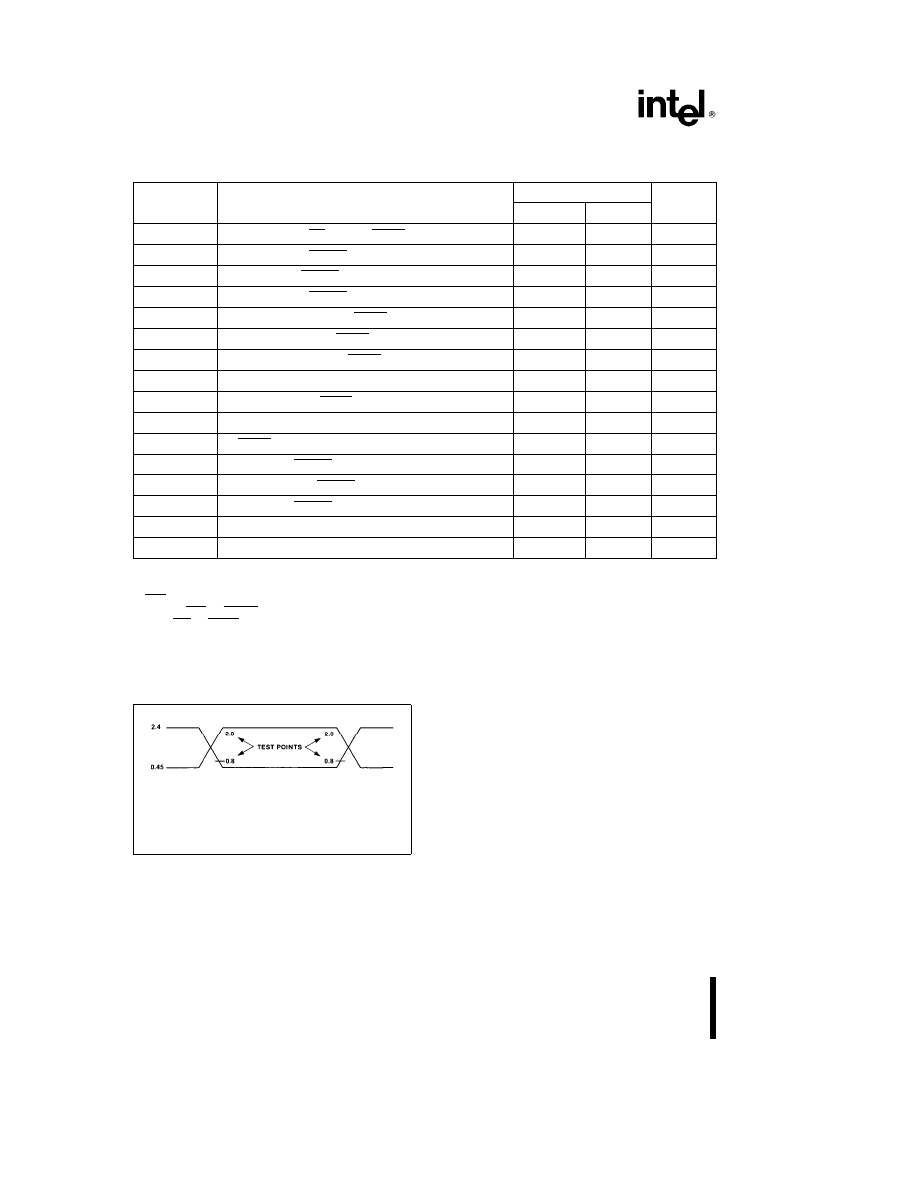
8237A
A.C. CHARACTERISTICSÐPERIPHERAL (SLAVE) MODE
T
A
e
0
§
C to 70
§
C, T
CASE
e
0
§
C to 75
§
C, V
CC
e a
5V
g
5%, GND e 0V
Symbol
Parameter
8237A-5
Unit
Min
Max
TAR
ADR Valid or CS LOW to READ LOW
50
ns
TAW
ADR Valid to WRITE HIGH Setup Time
130
ns
TCW
CS LOW to WRITE HIGH Setup Time
130
ns
TDW
Data Valid to WRITE HIGH Setup Time
130
ns
TRA
ADR or CS Hold from READ HIGH
0
ns
TRDE
Data Access from READ LOW (Note 5)
140
ns
TRDF
DB Float Delay from READ HIGH
0
70
ns
TRSTD
Power Supply HIGH to RESET LOW Setup Time
500
ns
TRSTS
RESET to First IOWR
2TCY
ns
TRSTW
RESET Pulse Width
300
ns
TRW
READ Width
200
ns
TWA
ADR from WRITE HIGH Hold Time
20
ns
TWC
CS HIGH from WRITE HIGH Hold Time
20
ns
TWD
Data from WRITE HIGH Hold Time
30
ns
TWWS
Write Width
160
ns
TWR
End of Write to End of Read in DMA Transfer
0
ns
NOTES:
1. DREQ and DACK signals may be active high or active low. Timing diagrams assume the active high mode.
2. EOP is an open collector output. This parameter assumes the presence of a 2.2K pullup to V
CC
.
3. The net IOW or MEMW Pulse width for normal write will be TCY
b
100 ns and for extended write will be 2TCY
b
100 ns.
The net IOR or MEMR pulse width for normal read will be 2TCY
b
50 ns and for compressed read will be TCY
b
50 ns.
4. TDQ is specified for two different output HIGH levels. TDQ1 is measured at 2.0V. TDQ2 is measured at 3.3V. The value
for TDQ2 assumes an external 3.3 KX pull-up resistor connected from HRQ to V
CC
.
5. Output Loading on the Data Bus is 1 TTL Gate plus 100 pF capacitance.
A.C. TESTING INPUT/OUTPUT WAVEFORM
231466 – 12
A.C. Testing: Inputs are driven at 2.4V for a Logic ‘‘1’’ and 0.45V
for a Logic ‘‘0.’’ Timing measurements are made at 2.0V for a
Logic ‘‘1’’ and 0.8V for a Logic ‘‘0.’’ Input timing parameters as-
sume transition times of 20 ns or less. Waveform measurement
points for both input and output signals are 2.0V for HIGH and
0.8V for LOW, unless otherwise noted.
14
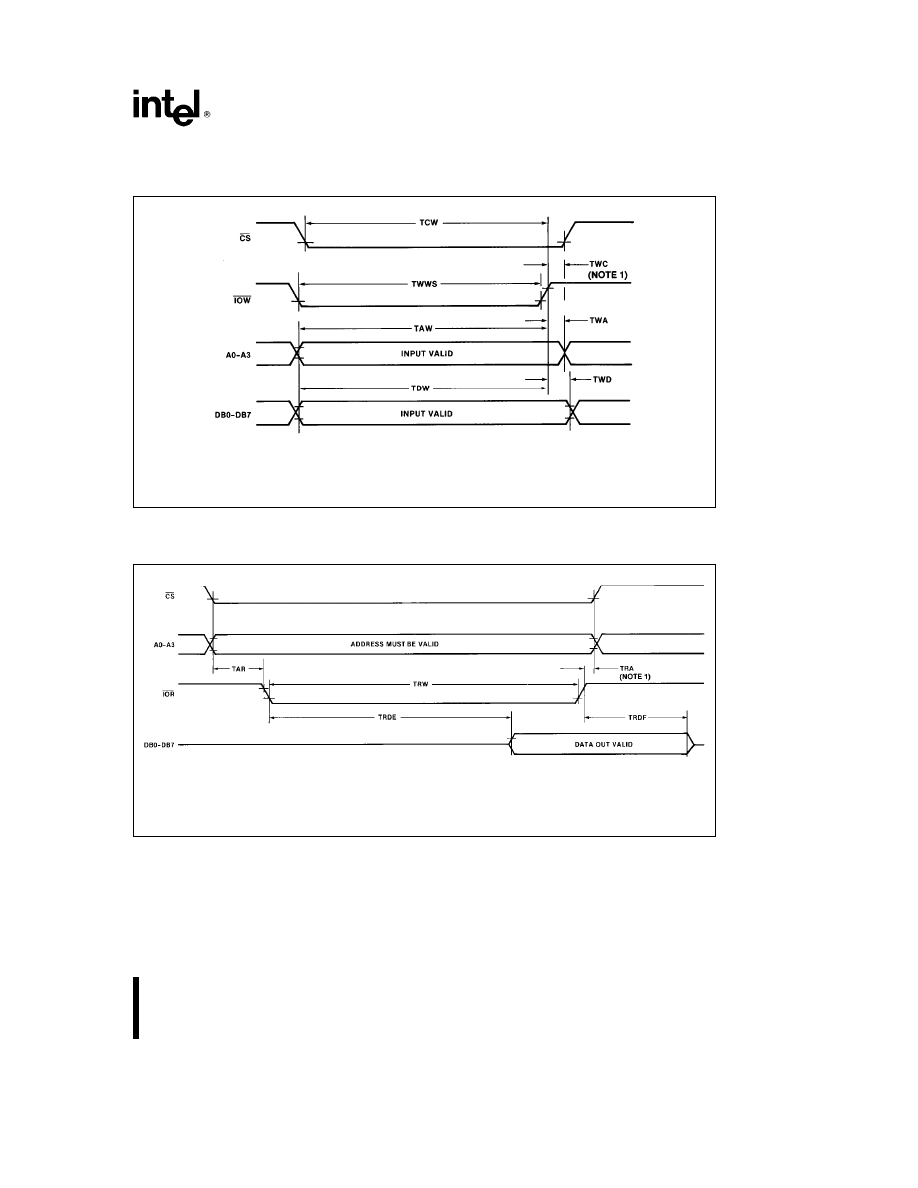
8237A
WAVEFORMS
SLAVE MODE WRITE TIMING
231466 – 13
NOTE:
1. Successive read and/or write operations by the external processor to program or examine the controller must be
timed to allow at least 400 ns for the 8237A-5 as recovery time between active read or write pulses. The same recovery
time is needed between an active read or write pulse followed by a DMA transfer.
Figure 9. Slave Mode Write
SLAVE MODE READ TIMING
231466 – 14
NOTE:
1. Successive read and/or write operations by the external processor to program or examine the controller must be
timed to allow at least 400 ns for the 8237A-5 as recovery time between active read or write pulses. The same recovery
time is needed between an active read or write pulse followed by a DMA transfer.
Figure 10. Slave Mode Read
15
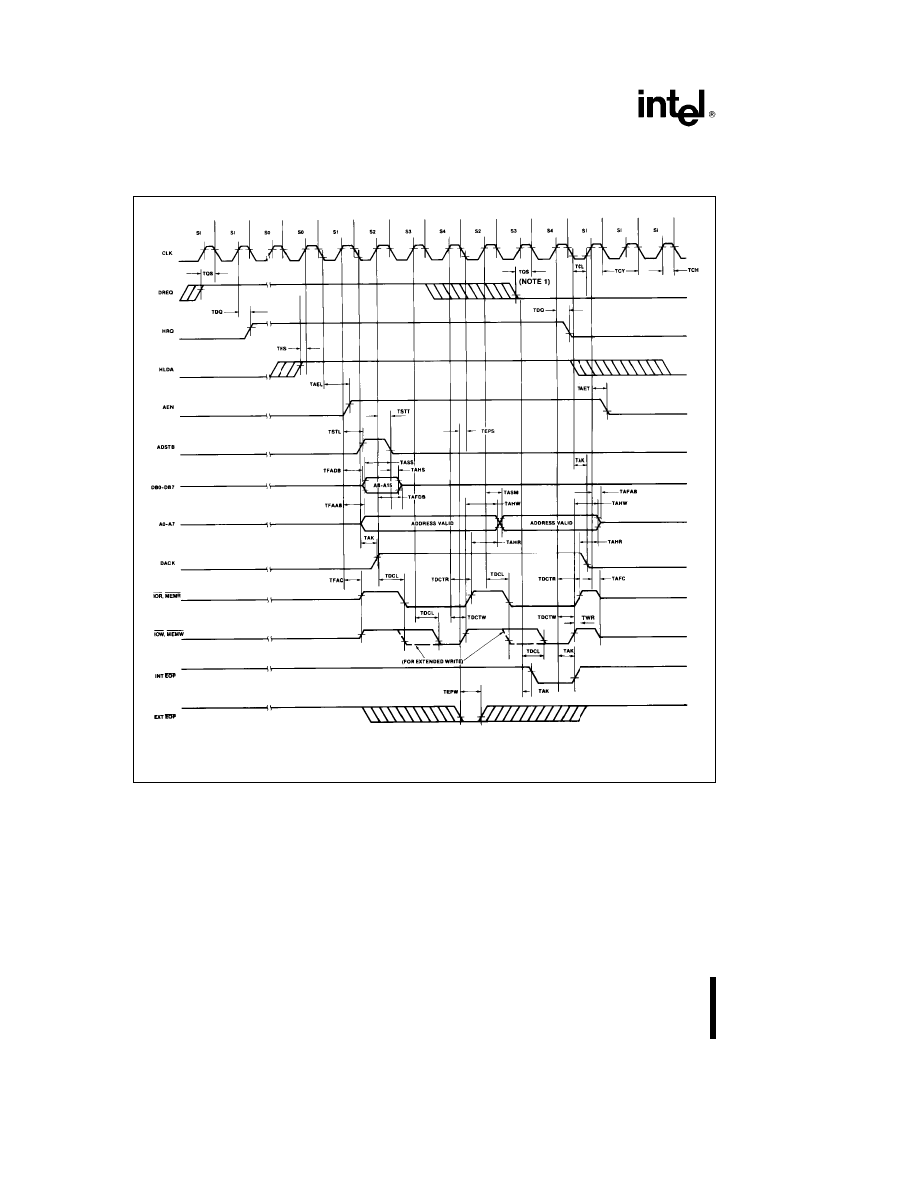
8237A
WAVEFORMS
(Continued)
DMA TRANSFER TIMING
231466 – 15
NOTE:
1. DREQ should be held active until DACK is returned.
Figure 11. DMA Transfer
16
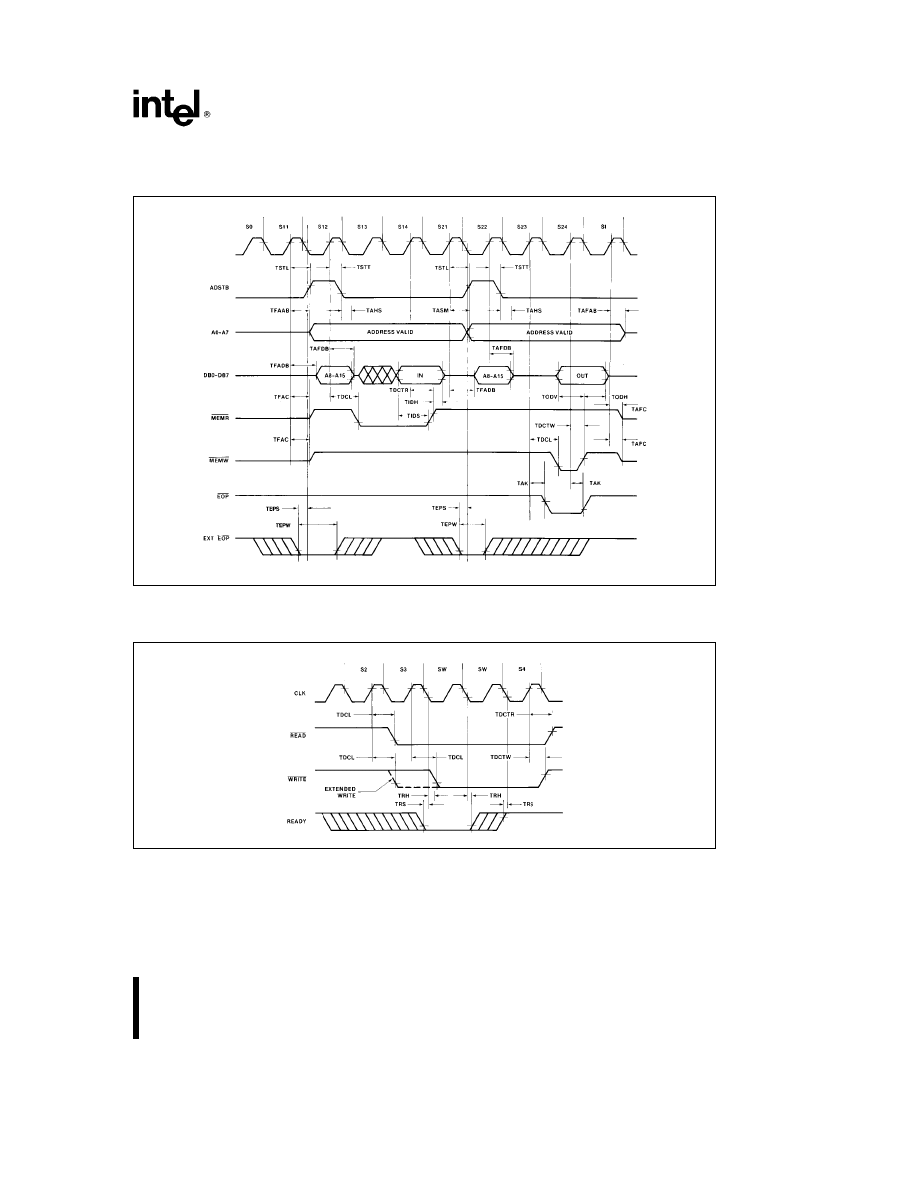
8237A
WAVEFORMS
(Continued)
MEMORY-TO-MEMORY TRANSFER TIMING
231466 – 16
Figure 12. Memory-to-Memory Transfer
READY TIMING
231466 – 17
Figure 13. Ready
17

8237A
WAVEFORMS
(Continued)
COMPRESSED TRANSFER TIMING
231466 – 18
Figure 14. Compressed Transfer
RESET TIMING
231466 – 19
Figure 15. Reset
18

8237A
DESIGN CONSIDERATIONS
1.
Cascading from channel zero.
When using mul-
tiple 8237s, always start cascading with channel
zero. Channel zero of the 8237 will operate incor-
rectly if one or more of channels 1, 2, or 3 are
used in the cascade mode while channel zero is
used in a mode other than cascade.
2.
Do not treat the DREQ signal as an asynchro-
nous input while the channel is in the ‘‘de-
mand’’ or ‘‘cascade’’ modes.
If DREQ becomes
inactive at any time during state S4, an illegal
state may occur causing the 8237 to operate im-
properly.
3.
HRQ must remain active until HLDA becomes
active.
If HRQ goes inactive before HLDA is re-
ceived the 8237 can enter an illegal state causing
it to operate improperly.
4.
Make sure the MEMR
Ý
line has 50 pF loading
capacitance on it.
When doing memory to mem-
ory transfers, the 8237 requires at least 50 pF
loading capacitance on the MEMR
Ý
signal for
proper operation. In most cases board capaci-
tance is sufficient.
5.
Treat the READY input as a synchronous in-
put.
If a transition occurs during the setup/hold
window, erratic operation may result.
6.
Any channel in cascade mode should have an
active DREQ before a HRQ.
DATA SHEET REVISION REVIEW
The following list represents key differences be-
tween this and the -003 data sheet. Please review
this summary carefully.
1. Item 6 was added to the ‘‘Design Considerations’’
section.
REVISION SUMMARY
The following list represents the key differences be-
tween rev. 004 and rev. 005 of the 1994 8237A Data
Sheet.
1. References to and specifications for the 8237A
and 8237A-4 are removed. Only the 8237A-5 5 MHz
device remains in production.
19
Wyszukiwarka
Podobne podstrony:
8237
8237
14 kontroler DMA 8237
8237
8237
8237
więcej podobnych podstron